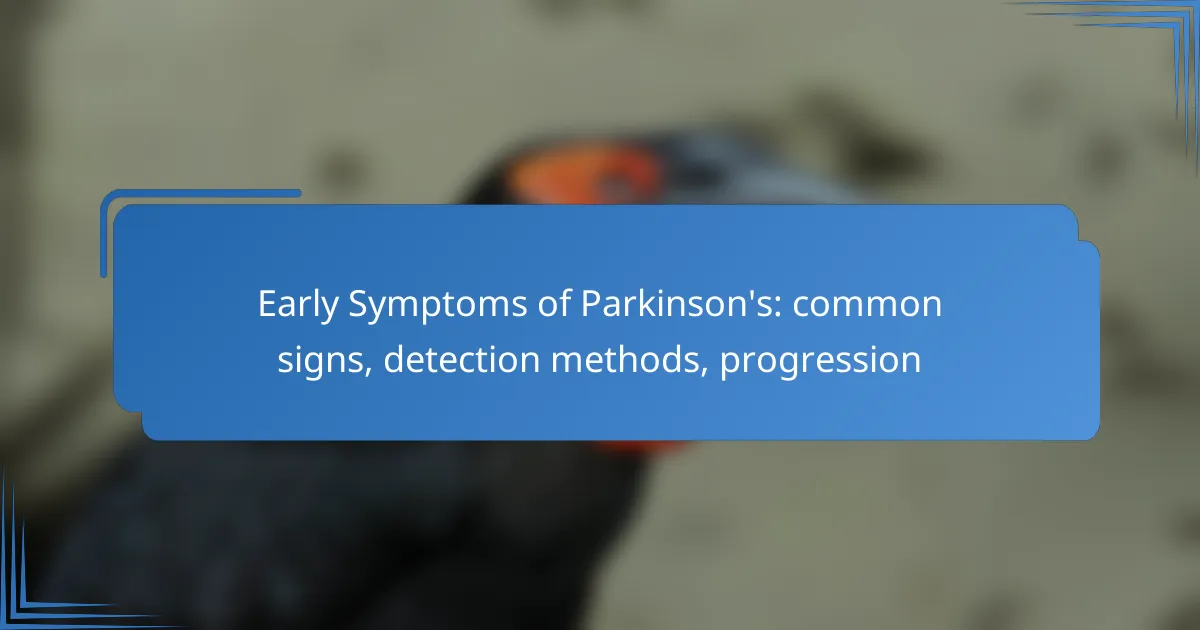Early symptoms of Parkinson’s disease can manifest as subtle physical changes that may initially go unnoticed. Recognizing these signs promptly is essential for timely diagnosis and effective management, ultimately enhancing the quality of life for those affected. Various detection methods, such as neurological examinations and movement tests, play a critical role in identifying these initial indicators.

What are the early symptoms of Parkinson’s in New Zealand?
The early symptoms of Parkinson’s disease in New Zealand can include a variety of physical changes that may not seem significant at first. Recognizing these signs early can lead to timely diagnosis and management, improving quality of life.
Tremors in hands or fingers
Tremors are often one of the first noticeable symptoms of Parkinson’s. They typically manifest as a slight shaking or rhythmic movement in the hands or fingers, particularly when at rest. This can affect daily activities such as writing or holding objects.
In New Zealand, these tremors may start subtly, often being mistaken for stress or fatigue. Observing whether the tremors occur consistently can help in identifying them as a potential early sign of Parkinson’s.
Stiffness in limbs
Stiffness in the limbs is another common early symptom of Parkinson’s. This rigidity can make movement more difficult and may be accompanied by discomfort or pain. Individuals may notice that their arms or legs feel tight or less flexible than usual.
In New Zealand, this stiffness can affect posture and lead to a shuffling gait. It’s important to consult a healthcare professional if stiffness persists, as it can significantly impact mobility and daily life.
Changes in handwriting
Changes in handwriting, known as micrographia, can occur early in Parkinson’s disease. Individuals may find that their writing becomes smaller and more cramped, making it difficult to read. This change can be frustrating and may affect communication.
In New Zealand, being aware of these changes can prompt early intervention. Practicing larger writing or using assistive devices can help manage this symptom effectively.
Difficulty with balance
Difficulty with balance is a significant early symptom of Parkinson’s. Individuals may experience unsteadiness or a tendency to fall, especially when turning or changing direction. This can lead to a fear of falling, which may further limit mobility.
In New Zealand, engaging in balance exercises or physical therapy can be beneficial. It’s crucial to address these issues early to maintain independence and prevent injuries.
Reduced facial expressions
Reduced facial expressions, or facial masking, is another early indicator of Parkinson’s. Individuals may notice that their face appears less animated, which can affect social interactions and communication. This symptom can lead to misunderstandings with others regarding emotions or reactions.
In New Zealand, awareness of this change can help individuals seek support or therapy to improve expressiveness. Practicing facial exercises may also assist in regaining some degree of expressiveness.

How can Parkinson’s be detected early?
Early detection of Parkinson’s disease is crucial for effective management and treatment. Various methods, including neurological examinations, patient history assessments, and movement tests, help identify the initial signs of this condition.
Neurological examinations
Neurological examinations are essential for detecting early signs of Parkinson’s. These assessments typically involve a thorough evaluation of motor skills, reflexes, and cognitive functions. A neurologist may check for tremors, rigidity, and balance issues during the examination.
Common tools used in these evaluations include the Unified Parkinson’s Disease Rating Scale (UPDRS) and other standardized tests that help quantify symptoms. Early identification through these examinations can lead to timely interventions.
Patient history assessments
Patient history assessments play a vital role in early detection of Parkinson’s disease. Healthcare providers gather information about symptoms, family history, and any previous medical conditions that may contribute to the diagnosis. This background can reveal patterns or risk factors associated with Parkinson’s.
During these assessments, patients may be asked about the onset and progression of symptoms such as changes in handwriting, sleep disturbances, or loss of smell. Understanding these factors can help clinicians make informed decisions regarding further testing or referrals.
Movement tests
Movement tests are critical for assessing the motor symptoms associated with Parkinson’s disease. These tests often involve observing the patient’s ability to perform specific movements, such as finger tapping or walking in a straight line. The results can indicate the presence of motor dysfunction.
Simple tasks, like the “pull test,” where a clinician gently pulls the patient backward to check for balance, can also provide insights. Consistent difficulties in these tests may warrant further investigation and monitoring for Parkinson’s progression.

What are the common signs of Parkinson’s progression?
Parkinson’s progression is often marked by a range of symptoms that can vary in severity and impact daily life. Common signs include increased difficulty with movement, speech changes, and sleep disturbances, which can all indicate the disease’s advancement.
Increased difficulty with movement
As Parkinson’s disease progresses, individuals may experience increased difficulty with movement, known as bradykinesia. This can manifest as slower walking, reduced arm swing, or difficulty initiating movement. Simple tasks like buttoning a shirt or getting out of a chair may become challenging.
It’s essential to monitor these changes, as they can affect independence. Engaging in regular physical therapy or exercise can help maintain mobility and flexibility. Activities like stretching or tai chi may be beneficial in managing these symptoms.
Speech changes
Speech changes are another common sign of Parkinson’s progression, often characterized by softer voice volume or slurred speech. This condition, known as hypophonia, can make communication more difficult and may lead to frustration in social situations.
Practicing speech exercises with a speech-language pathologist can aid in improving vocal clarity and volume. Using tools like voice amplification devices may also help individuals communicate more effectively in group settings.
Sleep disturbances
Sleep disturbances are prevalent in those with Parkinson’s disease, often including insomnia, restless legs, or frequent awakenings. These issues can significantly impact overall quality of life and exacerbate daytime fatigue.
Establishing a consistent sleep routine and creating a comfortable sleep environment can improve sleep quality. Avoiding caffeine and electronic devices before bedtime may also help alleviate some sleep-related difficulties.

What are the risk factors for developing Parkinson’s?
The risk factors for developing Parkinson’s include age, genetics, and environmental influences. Understanding these factors can help in early detection and management of the disease.
Age-related risks
Age is one of the most significant risk factors for Parkinson’s, with the likelihood of developing the condition increasing as individuals grow older. Most cases are diagnosed in people over the age of 60, although early-onset Parkinson’s can occur in younger adults.
As people age, the brain undergoes various changes that may contribute to the degeneration of neurons responsible for producing dopamine, a key neurotransmitter affected in Parkinson’s. Regular health check-ups can help monitor symptoms as one ages.
Genetic predispositions
Genetic factors can play a crucial role in the development of Parkinson’s. Individuals with a family history of the disease may have a higher risk due to inherited genetic mutations. Specific genes, such as SNCA and LRRK2, have been associated with familial forms of Parkinson’s.
While having a genetic predisposition does not guarantee the onset of Parkinson’s, it can increase the likelihood, especially when combined with other risk factors. Genetic counseling may be beneficial for those with a family history of the disease.
Environmental exposures
Environmental factors, such as exposure to certain toxins and chemicals, can increase the risk of developing Parkinson’s. Pesticides, heavy metals, and industrial solvents have been linked to a higher incidence of the disease.
Living in rural areas where pesticide use is prevalent or working in occupations with high exposure to harmful substances may pose additional risks. Awareness and minimizing exposure to these environmental hazards can be an important preventive measure.

What are the treatment options available in New Zealand?
In New Zealand, treatment options for Parkinson’s disease primarily include medication therapies and physical therapy. These approaches aim to manage symptoms and improve quality of life for individuals diagnosed with the condition.
Medication therapies
Medication therapies for Parkinson’s disease focus on replenishing dopamine levels in the brain or mimicking its effects. Common medications include levodopa, which is often combined with carbidopa to enhance its effectiveness and reduce side effects.
Patients may also be prescribed dopamine agonists, which stimulate dopamine receptors directly. It’s essential to work closely with a healthcare provider to find the right medication and dosage, as responses can vary significantly among individuals.
Physical therapy
Physical therapy plays a crucial role in managing Parkinson’s symptoms by improving mobility, balance, and overall physical function. Tailored exercise programs can help maintain strength and flexibility, which are vital for daily activities.
Therapists often incorporate techniques such as gait training and balance exercises. Regular physical activity is recommended, with many experts suggesting at least 150 minutes of moderate exercise weekly to optimize benefits.
